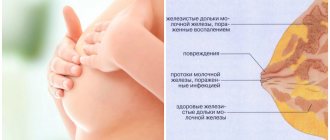The importance of the first attachment for mother and baby
Attachment to the breast is the logical end of the birth process, which gives a powerful impetus to the establishment and establishment of lactation. Ideally, attachment should take place immediately after the baby is born. The baby is born and cries, the midwife lays it “belly to belly” towards the mother, helping to find the nipple.
The mother's body is prepared and adjusted to breastfeeding if the newborn is attached immediately after birth. Sucking the breast gives a signal that labor is over, and the woman’s body’s task is to feed the baby with milk. Baby sucking at the breast activates nerve endings in the mother's body that are responsible for active contractions of the uterus, which leads to a reduced risk of developing postpartum complications.
Attachment is of particular importance for the baby. He receives the first drops of colostrum, which activate protective reserves. They help the child cope with pathogenic bacteria and allergens. Colostrum, containing a large amount of antibodies, protects the baby from diseases. It helps in populating the intestinal microflora with beneficial bifidobacteria.
The psychological role of early attachment is also important. During childbirth, the child is exposed to stress, finds himself in unfamiliar conditions, and the baby needs his mother to feel safe. Mom's touch, physical contact, and breast sucking help reduce postpartum stress and establish a tight emotional “mother-child” connection, which is called “imprinting.”
It has been established that breastfeeding increases the level of pleasure hormone in a woman’s blood -
endorphin, allowing you to relax and unwind even after a difficult birth.
Rules for first breastfeeding
In the first day, it is necessary to put the baby to the breast more often. This helps to calm down, survive the stress of childbirth, and is an impetus for the establishment of lactation. Now the baby eats a lot, sleeps and cries, but this does not indicate hunger, rather a reaction to stress. To calm your newborn, you need to pick him up and offer your breast.
The first feeding occurs a couple of hours after birth, when mother and baby have rested a little. To make breastfeeding enjoyable and not painful, you need to choose a suitable position - this contributes to the correct latch on the breast. At first, the mother experiments with feeding positions to find one in which she will be comfortable and the breast will be emptied as much as possible by the baby.
Milk appears on the second or third day after birth. Colostrum appears first. It is unique in composition, yellow in color, thick in consistency, similar to the composition of blood, and has a mild laxative effect, which helps cleanse the intestines of meconium.
The baby may lose weight in the first days - this is normal. Within 3-4 days of life, body weight can decrease by 10% (urine, meconium, fluid loss during breathing and through the skin are excreted). The newborn's stomach capacity is small and he only needs a couple of drops of colostrum to feel full.
Duration of breastfeeding
In the first week after birth, breastfeeding should be carefully maintained, even if the baby sucks little milk. A child needs food from 8-10 to 12 times a day. Feeding should be done as soon as the newborn needs to eat.
The first months of a baby’s life are the most important in the formation of all vital organs, as well as in adaptation to a new environment. At this stage of a child’s life, it is important to follow the rules of breastfeeding, so as not to lead to overfeeding in the future. To prevent such a situation, a nursing woman should carefully monitor the baby’s behavior and take into account all his actions before and after feeding. Also during lactation it is necessary to learn to distinguish between impulses of crying and anxiety from hunger. In the first months of life, it is necessary to feed a baby for no more than 20 minutes, with subsequent feedings 7-8 times with a duration of 10-15 minutes.
Free breastfeeding establishes psycho-emotional contact between the baby and his mother. This is important for the child and the future development of his intellect.
Medical contraindications to breastfeeding a newborn.
The child has:
- low health score on the Apgar scale (below 7 points);
- prematurity (weight less than 1500 g);
- suffocation, respiratory distress syndrome;
- birth injuries;
- congenital developmental defects that prevent latching and sucking on the breast.
Mom:
- moderate to severe renal failure;
- severe blood loss during and in the postpartum period;
- lack of consciousness in the woman in labor;
- open form of tuberculosis;
- malignant neoplasms;
- HIV infection.
In most cases, the baby can be put to the breast after the condition of the mother and child has normalized.
The importance of early breastfeeding
Early application is good because it gives:
- ensuring rapid interaction of milk supply reactions and the formation of stable subsequent lactation;
- the ability to independently produce oxytocin, which contracts the uterus after the birth of a child and reduces the risk of bleeding in a woman;
- has a sedative effect on a woman due to physical contact between the child and the mother;
- manifestation of the maternal instinct, which forms an attitude toward prolonged breastfeeding;
- the newborn's ability to adapt to the environment;
- Provides the baby's digestive tract with beneficial microflora and strengthens the immune system.
However, there are contraindications for early breastfeeding due to the woman’s health condition:
- surgical intervention during childbirth;
- chronic form of gestosis (late toxicosis);
- open bleeding during labor;
- tuberculosis, hepatitis;
- chronic diseases of internal organs;
- endometriosis;
- acute mental disorders;
- viral infections;
- HIV, herpes.
There are also contraindications to early attachment due to the health status of the newborn:
- the baby’s health status on the Apgar scale is below 7 points;
- entanglement of the umbilical cord of a newborn;
- cerebral vascular disorder;
- prematurity;
- severe form of congenital defects.
Subsequent stages of breastfeeding with this type of disorder should be completely excluded. The list of prohibitions primarily includes hereditary predisposition and enzymopathy.
Early latching of the baby to the breast and frequent feeding help to avoid a number of diseases, because colostrum has a laxative effect, due to which the intestines are cleared of meconium several times faster. Breastfeeding also helps to avoid bile storage syndrome and jaundice.
Signs of proper breastfeeding
Much has been written about putting a baby to the breast, and it seems that the process of feeding a baby is laid down at the level of maternal instincts and problems cannot arise. But many mothers are faced with the fact that feeding is painful, the baby does not latch onto the breast, does not suck well, and the mother cannot attach the baby to the breast correctly.
Correct application:
- Lips at an angle of 120-150 degrees. The muscles of the mouth are relaxed, the lips are like a tube.
- The lower lip is turned outward.
- If the baby is attached correctly, the baby's lower lip and chin will sink into the chest. This can be seen when the chest is pulled back.
- The baby's mouth is wide open. The lower jaw is directed downwards.
- Sucking involves all the muscles from the chin to the temple.
- The cheeks are not retracted.
- The tongue lies on the lower gum; if you bend the lower lip, you can see how the tongue works.
- There are no sounds of smacking or clicking. Only the sounds of swallowing can be heard.
- After feeding, the nipple is not deformed, there are no bevels or flattening.
- The main sign is that feeding does not hurt.
Please note that not all signs are achievable due to the anatomical features of the baby (short frenulum, spasm of the muscles involved in sucking.

The meaning of the first breastfeeding
Imagine - for nine months the baby lived, grew and developed in his mother’s belly, where it was quiet, warm, and cozy. He constantly felt the beating of her heart, heard his native voice. And suddenly everything changed - the warm water surrounding him disappeared somewhere, it became very light and noisy, cold and uncomfortable. And most importantly, the beating of my mother’s heart has disappeared somewhere, she is no longer around!
Of course, this is a huge stress for a newborn. He will cope with it; separation from his mother immediately after birth will not be fatal for him. But it has been proven by numerous studies: those babies who, immediately after birth, were placed on their mother’s stomach and chest, then grew more active, healthier, latched better and slept more peacefully.
Important
The official position of WHO is that the first time a newborn is put to the breast should occur no later than an hour after birth.
Western scientists are convinced: if in the first minutes of his life a baby feels his mother’s caring hands and hears a gentle and familiar voice, it will be easier for him to build relationships with the outside world and people in adulthood.
It is also important for the youngest mother to put the baby to the breast early . When a woman sees her baby for the first time, can hug him, feel the warmth of a small body, the weak, still unconscious squeeze of tiny, tender fingers, the maternal instinct inherent in nature awakens in her.
It is noteworthy that after the first attachment, the first contact with the child, those women who had previously wanted to abandon the child changed their minds and took the newborn home.
Pumping
If, after a hot flash, there is swelling in the chest, causing a fever, you need to wait a day from the start of the hot flash, often put the baby to the breast, and change breasts.
If there is no relief, the breasts are painful, swollen, the temperature has risen, then you need to express as much as possible no later than 9 pm and no earlier than 9 am.
Afterwards, 2-3 pumping sessions are required until the breasts are relieved and not empty. If you start actively pumping, this will lead to a large number of hot flashes with possible stagnation of milk - lactostasis.
Let's sum it up
So, in order to finally find out why the baby is placed on the mother’s breast immediately after birth and why this is so important, the following points should be noted:
- Early application promotes intense contractions of the uterus and rapid expulsion of the placenta - usually the woman in labor does not notice this moment. And postpartum bleeding goes away faster and less painful.
- When the baby takes the breast, the lactation mechanism starts and milk begins to be intensively produced.
- Emotional contact is established between the newborn and the mother in labor.
- Together with drops of colostrum, the baby receives everything necessary to protect against pathogenic microflora and develop the immune system.
- The baby calms down and feels protected; in the future he develops better and behaves calmer.
Imprinting is the name in the West for the connection that is established between a baby and his mother in the first minutes after birth . The baby remembers on a subconscious level exactly his parent and from now on is drawn only to her. He captures her voice, her smell, her warmth. From now on, there is a deep connection between mother and child that will last until the end of life. This is why early breastfeeding is so important.
9, total, today
( 171 votes, average: 4.63 out of 5)
Pedagogical complementary feeding during breastfeeding: table and recommendations
Kefir as a complementary food: how and when to introduce?
Related Posts
Difficulty breastfeeding
The baby does not latch on to the breast
- baby turns his head
- grabs the chest several times and throws
These are manifestations of the search reflex.
What to do:
- pass the nipple over the baby's lips and cheeks
- express a couple of drops of colostrum and apply it to the areola and nipple
- hold the baby's head, help find the nipple.
Baby sucks poorly
- The child is restless due to hunger.
- sucks sluggishly, quickly falls asleep.
Occurs in weakened premature babies, during difficult births, and jaundice.
What to do:
- Wake up the baby for feeding (every 1.5-2 hours during the day, every 3-4 hours at night).
- skin-to-skin contact.
- help the baby find the breast.
If you can’t wake him up, you need to express each breast for 10-15 minutes.
Short bridle
Causes difficulty when sucking, you can hear clicking and smacking sounds.
What to do:
- See your dentist for a frenulum trimming
Tight breasts
Milk is difficult to separate and it is difficult to breastfeed
. What to do:
- increase application frequency.
- Before feeding, stretch your breasts and express some milk.
Nipple shape
Difficulties with inverted or flat nipples
What to do:
- pick a pose
- use nipple formers and silicone nipple covers.
Not enough milk
What to do:
- increase the volume of fluid consumed (2.5-3 l.)
- Drink a warm drink before feeding.
- apply to the breast more often, especially at night. Between 3-4 am, the hormone responsible for the amount of milk, prolactin, is produced.
- Monitor your nutrition and caloric intake. Eat 5-6 times a day in small portions.
A lot of milk
What to do:
- reduce the amount of liquid
- Express your breasts before feeding.
- express breasts after feeding to prevent congestion and mastitis.
- Use breast pads to protect clothing from leaks.
Dummy
Due to pacifier sucking, the baby is less likely to attach to the breast.
Less milk is produced. The child prefers the pacifier to the breast. What to do:
- Limit your child from sucking a pacifier
- offer breasts more often.
First breastfeeding. Is it important?
Over the last decade, many maternity hospitals around the world have been practicing early latching of a newborn to the breast, almost immediately after his birth. During an uncomplicated birth, the baby, not yet washed, covered in mucus and blood, is placed on the mother’s chest or stomach.
According to UNICEF (UN Children's Fund) experts, it is necessary to put a baby to the breast in the first 20-30 minutes after birth. This helps the baby cope with the stress of birth more easily: feel a familiar smell, warmth, heartbeat, sound of a voice. It is believed that with early application, the process of completing labor is accelerated, uterine contractions are stimulated, and as a result, the placenta leaves faster. Early attachment of the baby to the breast contributes to an increased flow of milk into the mother's breast, and then longer lactation.
Watch the video course “Everything about breastfeeding” with expert answers to all the most pressing questions about breastfeeding.”
Colostrum is not milk yet, it is yellow in appearance, has a thick and very nutritious consistency. The composition is closer to blood than to milk.
The woman may have been given medication or had a caesarean section. A newborn may still suck weakly. But none of this matters. The main thing for the obstetrician is to bring the baby’s mouth to the mother’s nipple and squeeze out a couple of drops of colostrum. It is useful for the baby. The necessary microflora will enter the baby’s intestines, not the maternity hospital’s, but its own. This way, the intestines will quickly get rid of meconium (original feces), and the effect of bilirubin, which provokes the occurrence of jaundice in newborns, will decrease.
But the main thing is that colostrum contains immunoglobulins that protect the baby’s fragile body from harmful microorganisms. Children who receive colostrum in the first minutes of life have stronger immunity.
Marina Zhinovan, obstetrician-gynecologist, candidate of medical sciences:
“The practice of early attachment, joint births came to our maternity hospital not long ago, fathers began to be allowed into the wards for several hours a day. Old school doctors are against these things. We, young specialists, see in this subtle moments of helping the psyche of women and children. We are going back to the basics, natural childbirth. The old guard, of course, of powerful doctors, views childbirth as an operation. They are determined that there will be complications and problems.”
The doctor says that not all obstetricians, at least in small town municipal maternity hospitals, consider early breastfeeding important. Although this is very physiological, justified and incredibly useful. Marina Aleksandrovna says that when women in labor ask to put their babies to the breast, only then they do. Often women are upset if this procedure was not carried out, they missed the opportunity to give colostrum immediately after childbirth, or if absolutely not a drop came.

Local doctors often play it safe. They say that there are many contraindications to early breastfeeding: difficult childbirth with complications, various diseases and pathologies (both of the woman and the newborn), and the mother taking certain medications.
Simply placing the newborn on the mother’s stomach will also be helpful. It is believed that this is the moment of formation of the mother’s attachment to the baby, and the baby’s to the mother.
The first attachment can take place later, a few hours after birth, natural or surgical, when the baby is washed, weighed, the nose is cleaned, and wrapped. And mom will be brought into relative order.
Read in our blog: “How to properly feed a newborn”
Most likely, you will have to make several attempts to get the baby to take the breast correctly, and seek help from a nurse or consultant. It is correct to attach the baby to the breast in such a way that the lower lip is turned out and the nipple is completely captured. It is a known fact that the first application stimulates milk production. His mother’s body produces oxytocin, the most important hormone responsible for lactation. Milk begins to be produced in a noticeable volume only 3-5 days after the first application. During these days, the baby either does not really eat, being saturated only with drops of colostrum, or the nurses feed him a little mixture. Usually these days the child loses weight, and this is normal. Decrease - about 10% of body weight at birth due to excretion of urine and meconium. By the time he is discharged, he normally reaches his birth weight and begins to gain rapidly.

As we know, earlier, in Soviet times and even in the recent past, babies in maternity hospitals were taken away immediately after birth, given to their mothers for a while to feed, and taken away at night to allow the mothers to recover. In those days, in general, children were sent to nurseries very early. And they found rational explanations for these actions. The pros and cons of various ways of interaction between mother and child can be listed for a very long time. Each time has its own truth. Each generation offers new options as the only true ones, tearing the system of the past to smithereens.
Marina Zhinovan, obstetrician-gynecologist, candidate of medical sciences:
“I urge women not to worry too much. Yes, world research is clear that colostrum is gold... But, working in conjunction with neonatologists, we do not see significant differences between children who received colostrum immediately, several hours or days after birth, or who did not receive it at all.”
Even if there is no milk or colostrum at all, this does not mean that there is something wrong with your health or that your relationship cannot be emotionally strong. Modern formulas can fully replace breast milk, including during the first feeding. Colostrum and milk are very important, but more important is just being there.
Top 15 tips for a nursing mother
- The first hours after birth are important for establishing lactation. Laying on your stomach will help with this.
- Underfeed formula while waiting for milk to come in.
- Avoid observance of hygiene rules to the point of fanaticism (Wash your hands with soap before feeding).
- Give breastfeeding on demand.
- Give up the pacifier.
- There is no need for additional soldering.
- Do not pump until your breasts are completely empty. Just until relief.
- Change breasts every 2 hours.
- Complementary foods should be introduced after 6 months.
- Learn and try different feeding positions.
- The optimal duration of feeding is 2-3 years.
- Ensure that your breast is latched correctly when feeding.
- Do not cancel night feedings.
- Mom's illness is not a reason to stop feeding.
- Use the services of lactation consultants.
Online consultation with a pediatrician (breastfeeding specialist)
consultation cost: 500 rubles
Online consultation
During the consultation, you will be able to voice your problem, the doctor will clarify the situation, interpret the tests, answer your questions and give the necessary recommendations.











